Different chemistries have been designed to turn curly hair straight, but in all cases questions remain about their safety, finds Rachel Brazil
Prolific inventor Garret Augustus Morgan Sr, born in 1877, began his career as a sewing-machine mechanic in Cincinnati, US, and ended it as the owner of G A Morgan Hair Refining Company – the first company to commercialise a hair-straightening treatment. In 1909, Morgan was in his newly opened tailoring shop and discovered that lubricants used to reduce needle friction also straightened the fibres of woollen fabric. After testing the solution on a neighbouring dog’s fur, and then on himself, he sold the first hair relaxing cream. By 1917 his formulation had evolved to contain sodium hydroxide, known as lye, still in many relaxing creams today. These products, designed for salon and home application, are now big business, with a global market value of $870 million (£695m) in 2022.
But using these products regularly can come at a cost. ‘If you talk to anyone who has relaxed their hair, the first thing that they will mention is the smell, the burning sensation, and for most people hair loss,’ says Ikamara Larasi, a campaigner for the London-based group Level Up. On top of this, the group is concerned about recent epidemiological studies showing correlations between use of hair relaxers and a higher risk of both breast and uterine cancer. The cosmetics industry insists their products are safe, and all chemical ingredients undergo rigorous testing, but in the US litigation is now under way to try and prove otherwise.
The chemical key to the traditional relaxing processes is breaking disulfide bonds in hair. ‘The disulfide bond is the most powerful bond in the human hair, that gives it its tensile strength,’ says chemist Patrick Obukowho, who runs Advantage Research Lab, an industry consultancy in ethnic hair product formulation in New Jersey, US. He explains hair is made from layers of the protein keratin, with an outer protective fish scale-like cuticle, surrounding an inner cortex of keratin filaments, which are held together by disulfide bridges between cysteine amino acids.
Breaking those bonds to permanently straighten hair needs a high pH, achieved using sodium hydroxide, which in the first relaxers was carried in an emulsion of water, petroleum jelly, mineral oil and emulsifiers. Straightener kits commonly containing up to 2.5% sodium hydroxide. ‘The sodium hydroxide has a pH of about 13, so it’s very aggressive,’ explains Obukowho. The hydroxide ions swell the cuticle to reach the cortex, where they break disulfide bonds, leading to a new bond between a cysteine residue and a dehydrated serine residue known as a lanthionate – and the process itself known as lanthionisation. After washing out the relaxer and neutralising the hair, it can be styled straight.
Alternative methods
By the 1980s the corrosive nature of lye, which often causes irritation on application, led companies to develop what have become known as ‘no-lye’ treatments, containing alternative hydroxides. The most common formulations use calcium hydroxide which is mixed with a liquid activator containing the strong nitrogenous base guanidine carbonate to form guanidine hydroxide, which has a slightly lower pH of 12–13. The difference between the two methods was investigated by L’Oreal researchers in 2013 using a tissue engineered skin model. They showed that lye creams led to a 350% increase in the expression of the cytokine prostaglandin E2 (PGE2), a molecule signalling inflammation, compared to 250% for no-lye creams.
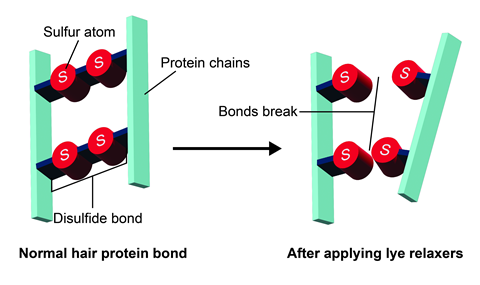
Other chemistries developed include thiol-based relaxers such as ammonium thioglycolate which also breaks disulfide bonds, but after styling the hair straight an oxidizing agent, often hydrogen peroxide or sodium bromate, will remake them. Similar to a perm, this method is less powerful, more expensive and also irritating to the skin.
In 2003 a new semi-permanent straightening treatment from Brazil gained popularity based on a slightly acidic rather than basic chemistry. The Brazilian keratin treatment (BKT) is a synthetic hydrolysed liquid keratin, extracted from sheep’s wool, designed to penetrate human keratin, and mixed with 1.5–5% formaldehyde – a chemical already commonly used in the wool and textile industry. When the hair is styled at a very high temperature, the formaldehyde released produces a hard film, cross-linked to the cortex keratin, that straightens the hair. Analysis indicates that complex reactions involving the side chains of amino acids such as serine and threonine acting as oxygen nucleophiles, take part in the reversible reaction.
Of course, the problem of formaldehyde’s toxicity soon became apparent. As well as causing eye, nose and respiratory tract irritation and headaches, it is a known carcinogen and banned from cosmetics in the EU. Its use in most countries is now widely restricted including in Brazil, where levels above 0.2% are prohibited. But illegal treatments with levels of up to 15% are still found there.
Alternative analogues such as glyoxylic acid (HCOCO2H) have also been marketed and were claimed to be safer. In 2011 another derivative, the dibasic amino acid glyoxyloyl carbocysteine, was introduced and promoted as formaldehyde free. But it was quickly shown to degrade on heating to release formaldehyde, albeit at lower levels. An Israeli study has also linked exposure to episodes of severe kidney injury following its use, likely due to the deposition of calcium oxalate crystals.
Preventing hair damage
A high proportion of relaxing treatments are still based on lye or no-lye formulations, but the evidence of damage to hair and skin is racking up. A 2022 review of 33 articles showed an association with eczema, skin damage, pain, burns, inflammation of the scalp, and hair loss. They have been linked to dermatitis and cicatricial alopecia – a type of hair loss caused by the destruction of the hair follicles. There is also little evidence that no-lye formulations are considerably less harsh. A 2019 study carried out in South Africa found both lye and no-lye hair relaxers, including those advertised for children, had levels of hydroxides deemed corrosive to the skin, with a median pH of 12.36 with no difference in formulations designed for children.
I’m still looking at other molecules that will get me the desired pH
‘The key factor is that over the years [manufacturers have] not really paid attention to the emulsion formation of such aggressive active ingredients,’ Obukowho says. ‘If the emulsion is not properly designed, then you will have all kinds of problems.’ He says it’s not possible to use the same types of emulsions found in other cosmetics, as these products require very specific emulsifiers and solvents, that for example, avoid the aggressive dissociation of sodium hydroxide.
Another important factor is the neutralising treatments provided to end the relaxation process which often rely on weak acid such as citric acid. Obukowho says this has also been a major industry mistake which results in the hair remaining at an elevated pH. ‘I don’t know how a chemist can explain neutralizing sodium hyroxide with citric acid?’ he says. Of course he jokes the solution is not to use hydrochloric acid or sulfuric acid in the neutralizing shampoo, but he has designed an alternative method patented in 2016, using vegetable oils and natural fatty acids such as oleic acid (C18H34O2) which are able to reset the hair pH to around 7.1–7.5, nearer to hair’s natural pH of between 4.5–5.5. ‘I’m still looking at other molecules that will get me the desired pH,’ he adds.
Epidemiological studies
While some of the mostly women who use hair relaxers might be prepared to put up with discomfort and even hair damage, recent studies reporting associations between cancer and these products are more alarming. In 2019 epidemiologist Alexandra White, from the US National Institute of Environmental Health Sciences, in North Carolina published a study showing an association between breast cancer and high use of relaxers especially among Black women. It was based on 10 years of data taken from the Sister Study, a US survey of approximately 50,000 sisters of women who have had breast cancer.
Using the same cohort in 2022, White also found an association between rarer uterine cancer and use of straightening products. Women who used the products multiple times a year were more than twice as likely to develop uterine cancer, although given the rare nature of this cancer, this was based on only 378 uterine cancer cases.
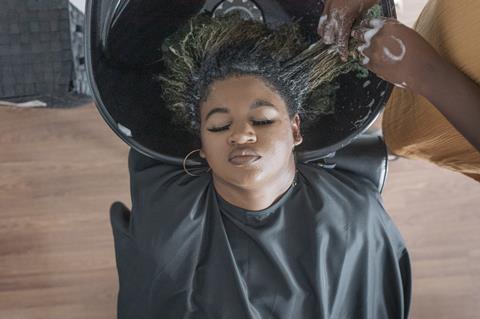
‘The increase in risk we saw for breast cancer (around 30%) was similar in magnitude to that observed for moderate alcohol consumption [i.e., 4 to 14 drinks per week] and breast cancer. For uterine cancer, the increase in risk (~2.5×) was similar to being obese (BMI 30–35kg/m2)’ says White. She adds these represent much smaller risks than cigarette smoking, where smokers are 15–30 times more likely to get lung cancer.
Several other published studies have picked up similar correlations. A 2021 study of approximately 50,000 Black women from Boston University’s Black Women Health Study found those who used lye-based relaxers at least seven times a year for over 15 years had around 30% increased risk of developing breast cancer but no association was found for non-lye products. In 2022, another study using longitudinal data from The Women’s Circle of Health Study, which recruited Black and white women with and without breast cancer, found use of relaxers for more than 10 years and use before the age of 12 was associated with increased risk of larger sized and more aggressive breast tumours.
We cannot say that these exposures are directly causing larger tumours
Of course these results only show a correlation and not a causal link. There could be other associated risk factors that would explain the findings. Michael Jones, an epidemiologist at The Institute of Cancer Research in London, UK, who is closely collaborating with White, says there is still need for wider confirmation from other population-based studies and studies in cells and animals. He agrees there may be other explanations for the findings even if the results are statistically significant.
There has also been some conflicting and confusing evidence; for example, a 2017 publication from the Women’s Circle of Health Study showed no association between relaxer use in Black women but an increased risk for white women. ‘We cannot say that these exposures or this pattern of exposure are directly causing larger tumours,’ says epidemiologist Adana Llanos from Colombia University in the US, who is an author of both the 2017 and 2022 breast cancer studies. ‘[But] these findings really do give us new hypotheses that we can test and in other studies.’
Pinpointing problems
Hypothesising which chemicals within hair-relaxing formulations may be causing these risks is also a challenge and so far the suspicion has fallen on hormone-mimicking endocrine-disrupting chemicals. ‘Studies also suggest that these products contain a number of endocrine-disrupting compounds. However, these constituents vary by brand and over time, which can make it challenging to identify the most relevant compounds,’ says White. Understanding the inflammatory properties of chemicals like sodium hydroxide could also be relevant: ‘Inflammation is one of the key drivers of cancer development, so it makes sense,’ says Llanos. But collecting evidence that could narrow down a chemical cause, if indeed there is one, will be hard. ‘Most of what we see as of now is based on what people remember or what they report in a questionnaire [and] many times, [they] don’t know if they were using a product that contains lye or not,’ says Llanos.
The results published over the last few years have spurred the UK group Level Up to campaign for L’Oreal, who owns several of the largest relaxer brands such as Dark and Lovely and SoftSheen-Carson, to withdraw these products until their safety can be assured. ‘We’re not scientists, but there have now been multiple studies,’ says Larasi, whose organisation is not alone in taking on L’Oreal. Since 2022 a growing number of US lawsuits are claiming hair straightening products sold by L’Oréal and several smaller companies have caused cancer and other health problems due to chemicals that disrupt the endocrine system. As of this March, there were 124 plaintiffs with pending cases .
L’Oreal have publicly responded that they believe these lawsuits have no merit and say they uphold the highest standards of safety for all their products which are subject to rigorous scientific evaluation of their safety by experts. Caroline Rainsford, head of scientific services at the UKs Cosmetic, Toiletry & Perfumery Association, agrees that consumers can be confident in the safety of hair relaxers sold in the UK. She says the recent studies have been reviewed: ‘Yes, they are finding an association, but that does not necessarily mean that is because there’s a link between two things, that one is causing the other.’ The US-based Personal Care Products Council also pointed out the most recent study linking uterine cancer showed a link between people who straighten their hair, rather than any particular ingredients in hair products, and suggested the study did not account for other confounding factors such as age of the first menstrual period, a higher BMI or lower physical activity.
No matter how you look at these exposures, we’re seeing statistically significant relationships, and we’re controlling for potential confounders
Rainsford points to the rigorous testing of all cosmetics and hair products in the UK and particularly for chemicals like sodium hydroxide, with known hazards which are already on a restricted list. This means they have been through very detailed safety assessments by an independent scientific panel. Since the UK left the EU it has had its own cosmetics regulations and a scientific advisory group on chemical safety in consumer products. ‘If any potential concerns come up with an ingredient, the government will then mandate this committee to do a review… and that does happen quite regularly,’ she explains.
A similar process exists in the EU, which in 2018 looked at a number of suspected endocrine-disrupting substances in cosmetics and only found evidence of endocrine-disrupting effects for the UV-filtering chemical 4-methylbenzylidene camphor which has now been banned. The UK committee has recently issued its own call for data to reassess suspected endocrine-disrupting chemicals.
Testing is extensive for new products, although cosmetics are no longer tested on animals. But they will undergo genotoxicity testing. The most common of these is the Ames test (Salmonella typhimurium reverse mutation assay) – a bacterial assay that measures its ability to induce mutations in several bacterial strains. The bacteria used have been engineered with mutations that inactivate a gene involved in the synthesis of histidine or tryptophan amino acids. When then exposed to a mutagen these mutations are reversed, allowing the bacteria to synthesize the amino acid and continue to grow. On top of this type of prior testing, companies have a continuing obligation to monitor the safety of their products and must record adverse reactions reported by consumers, althoughit seems unlikely that this would pick up the consequences of long-term exposure.
Weighing up the risks
So far no scientific organizations have concluded that there is an association between hair products and cancer incidence, but Llanos thinks the preponderance of evidence now points to a link, and while more research is needed it is time to invoke the precautionary principle. ‘I would not agree that there’s nothing to worry about,’ she says. ‘The studies that have been published, have been published in various study samples, different populations, different characteristics, and no matter how you look at these exposures, we’re seeing statistically significant relationships, and we’re controlling for potential confounders.’
Llanos argues one important and overlooked issue is how chemicals in these products interact with each other and the impact of small exposures over long periods of time. ‘A lot of people that are using these kinds of products, or have used them in the past, will have had their first relaxer [treatment] as a child, so some people have been relaxing their hair for 20 years or more,’ says Larasi. For her, this is also part of the larger issue of poorer health outcomes for Black women. US statistics show they are dying of breast cancer at a nearly 40% higher rate than white women with no clear reasons why. Llanos, whose work seeks to understand the molecular and sociobiologic contributors to inequities in cancer outcomes, thinks this could be another example of the unequal burden of toxic chemical exposure; an inequality that we need to fix.
I think it is important that there’s awareness about the potential for these beautifying agents to cause us harm
Regardless of the potential cancer risks, there is clearly still a need for new chemistries to straighten hair without causing as much damage. Obukowho agrees that so far this has not received enough attention. He would also like to see more research into differences in hair properties, especially in people of African descent. He says there are differences based on both genetics, environment and lifestyle factors.
The question of whether women should stop using these products is a difficult one for Llanos and she says she is conflicted. ‘I don’t feel like I’m in a position to tell people they shouldn’t make themselves look beautiful, whatever they believe beautifies them, but at the same time, what I do think is more important, is that there’s awareness about the potential for these beautifying agents to cause us harm.’ White suggests considering less frequent use, as this was not strongly associated with risk in her studies.
But for some Black women, the idea of stopping hair relaxing treatments is complicated by the wider societal bias toward Eurocentric beauty standards, even in professional life. ‘When you’re in a society where there’s often dress codes that explicitly talk about hair in a way that’s going to impact Black women, it’s not going to be that straightforward,’ says Larasi.
Rachel Brazil is a science writer based in London, UK
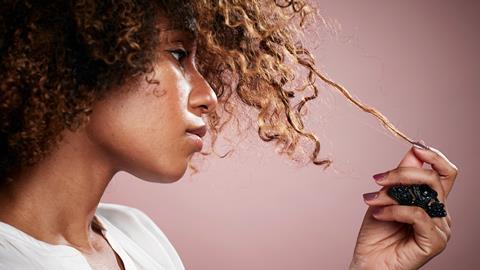




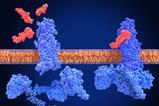

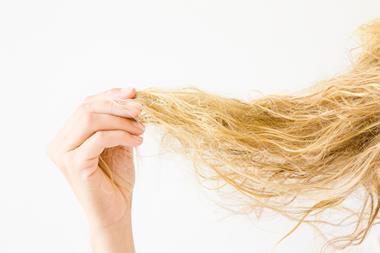
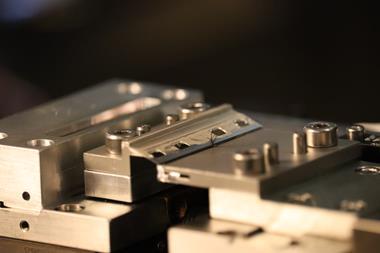









No comments yet